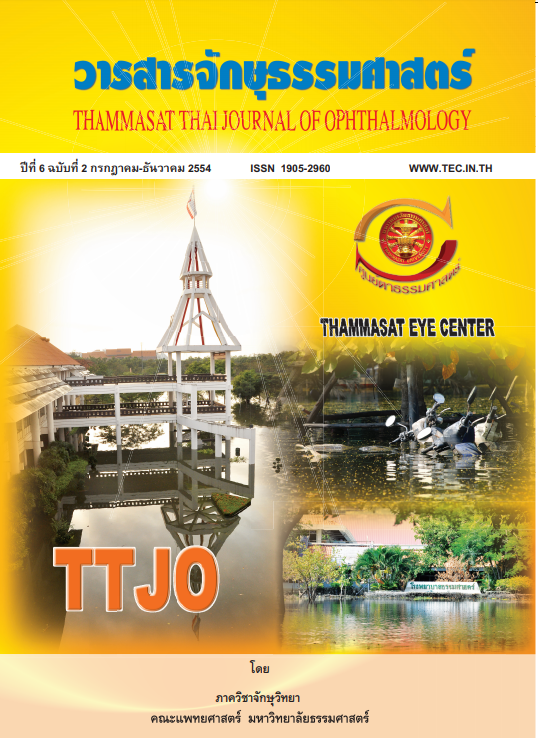Comparing method of Water Drinking Test in detecting peak Intraocular Pressure in primary open angle glaucoma
Main Article Content
Abstract
Introduction: Intraocular pressure (IOP) rise detected during water drinking test (WDT) can predict peak IOP during a 24-hour diurnal tension curve and relate to glaucoma progression. Unfortunately, 1000-mL WDT is not practical for daily fl uid intake habit and may
increase the risks of some systemic diseases.
Objective: To compare intraocular pressure (IOP) rise between two drinking methods: 1) four ingestion of 250-mL (4*250 mL) WDT 2) a standard 1000-mL (1*1000 mL) WDT.
Methods: Twenty-three POAG patients were included in this prospective study. The WDT was performed, followed by taking 4 doses of 250 mL water every 15 minutes. A 1000 mL WDT was performed after a minimum washout period of 1 week. IOP were measured before WDT and at 15, 30, 45, 60 minutes after WDT. Statistical analysis was performed by paired T-test.
Results: There was no statistically signifi cant difference of peak IOP between 4*250 and 1*1000 group. (mean 4.91±3.94 mmHg, 5.87 ±3.85 mmHg, respectively; p = 0.333). There was a statistically signifi cant IOPrising from baseline at 15 minutes in both 4*250 (mean 4.26±3.79 mmHg; p = 0.000) and 1*1000 group (mean 5.35±3.94 mmHg; p = 0.000), at 30 minutes in both 4*250 (mean 2.52±3.58 mmHg; p = 0.003) and 1*1000 group (mean 4.17±3.87 mmHg; p = 0.000). At 45 minutes, there was a statistically significant IOP rising from baseline only in 1*1000 group (mean 2.48±3.17 mmHg; p = 0.001).
Conclusion: 4*250 mL WDT can be used to estimate the peak diurnal IOP and assess the risk for glaucoma progression as 1*1000 mL WDT.
การเปรียบเทียบผลการเพิ่มขึ้นของความดันตาจากการทดสอบด้วยการดื่มน้ำปริมาณที่แตกต่างกันในผู้ป่วยโรคต้อหินมุมเปิด
บทนำ : ความดันในลูกตาที่เพิ่มสูงขึ้นภายหลังการทดสอบด้วยการดื่มน้ำ (water drinking test) สามารถใช้พยากรณ์ความดันตาที่สูงสุดในช่วง 24 ชั่วโมง (24-hour diurnal tension) และพบว่ามีความสัมพันธ์กับการแย่ลงของโรคต้อหิน แต่การทดสอบด้วยการดื่มน้ำปริมาณ1000 มิลลิลิตรในคราวเดียวไม่เป็นที่นิยมเนื่องจากมีข้อจำกัดในโรคบางประเภท อีกทั้งไม่ใกล้เคียงกับพฤติกรรมการดื่มน้ำในชีวิตประจำวัน
วัตถุประสงค์ : เพื่อเปรียบเทียบความดันตาที่สูงขึ้นหลังจากการทดสอบด้วยการดื่มน้ำ2 วิธี:
1) ดื่มน้ำปริมาณ 250 มิลลิลิตร 4 ครั้ง (4*250 มล.)
2) วิธีมาตรฐาน คือดื่มน้ำปริมาณ 1000 มิลลิลิตร 1 ครั้ง (1*1000 มล.)
วิธีดำเนินการวิจัย : การวิจัยแบบโพรสเปกทีป (prospective) นี้ทำในผู้ป่วยโรคต้อหินมุมเปิดจำนวน23 คน ในโรงพยาบาลธรรมศาสตร์เฉลิมพระเกียรติโดยทดสอบด้วยการดื่มน้ำปริมาณ 250 มิลลิลิตร ห่างกัน15 นาที 4 ครั้ง หลังจากนั้น 1 สัปดาห์ จะทดสอบด้วยการดื่มน้ำปริมาณ 1000 มิลลิลิตร 1 ครั้ง ในเวลา15 นาที และวัดความดันตาก่อนทำการดื่มน้ำ และที่เวลา15, 30, 45, 60 นาทีภายหลังการดื่มน้ำจนครบปริมาณที่กำหนด ทำการวิเคราะห์ทางสถิติด้วยวิธี paired T-test.
ผลการวิจัย : ไม่พบความแตกต่างกันอย่างมีนัยสำคัญทางสถิติของความดันตาที่เพิ่มสูงขึ้นภายหลังการดื่มน้ำทั้งสองวิธี (ค่าเฉลี่ย 4.913.94 มิลลิเมตร ปรอท (4*250 มล.), 5.873.85 มิลลิเมตรปรอท(1*1000 มล.); p = 0.333). พบความแตกต่างอย่างมีนัยสำคัญทางสถิติระหว่างค่าความดันตาก่อนดื่มน้ำและหลังจากดื่มน้ำที่ 15 นาที ทั้งกลุ่ม 4*250 มล. (ค่าเฉลี่ย4.263.79 มิลลิเมตรปรอท; p = 0.000) และกลุ่ม1*1000 มล. (ค่าเฉลี่ย 5.35±3.94 มิลลิเมตรปรอท;p = 0.000), ที่ 30 นาทีทั้งกลุ่ม 4*250 มล. (ค่าเฉลี่ย2.523.58 มิลลิเมตรปรอท; p = 0.003) และกลุ่ม1*1000 มล. (ค่าเฉลี่ย 4.173.87 มิลลิเมตรปรอท;p = 0.000), ที่ 45 นาทีเฉพาะกลุ่ม 1*1000 มล. (ค่าเฉลี่ย2.483.17 มิลลิเมตรปรอท; p = 0.001)
สรุป : การดื่มน้ำปริมาณ 250 มิลลิลิตร 4 ครั้งสามารถนำมาใช้พยากรณ์ความดันตาที่ขึ้นสูงสุดในช่วง24 ชั่วโมง (24-hour diurnal tension) เพื่อติดตามการแย่ลงของโรคต้อหินมุมเปิดได้เช่นเดียวกับวิธีมาตรฐาน คือดื่มน้ำปริมาณ 1000 มิลลิลิตร 1 ครั้ง
Article Details
References
Quigley HA, Broman A T. The number of people with glaucoma worldwide in 2010 and 2020.
Br J Ophthalmol 2006;90:262-267.
Bengtsson B, Leske MC, Hyman L, et al., Early Manifest Glaucoma Trial Group. Fluctuation
of intraocular pressure and glaucoma progression in the early manifest glaucoma trial. Ophthalmology.
Feb;114(2):205-9.
Asrani S., Zeimer R. and Wilensky J. et al., Large diurnal fl uctuations in intraocular pressure
are an independent risk factor in patients with glaucoma, J Glaucoma 9 (2000), pp. 134–142.
Collaer N., Zeyen T. and Caprioli J., Sequential office pressure measurements in the management
of glaucoma, J Glaucoma 14 (2005), pp. 196–200.
Caprioli J, Coleman AL. Intraocular pressure fluctuation a risk factor for visual field progression at low intraocular pressures in the advanced glaucoma intervention study. Ophthalmology. 2008 Jul;115(7):1123-1129.
Drance SM. Diurnal variation of intra-ocular pressure in treated glaucoma. Arch Ophthalmol.
;70:302-11.
Hughes E, Spry P, Diamond J. 24-hour monitoring of intraocular pressure in glaucoma management:
a retrospective review. J Glaucoma 2003;12:232–6.
Wolfgang L. The Water-Drinking Test. Br J Ophthalmol 1950; 34: 457-479.
Leydhecker W. Evaluation of the water-drinking test. Br J Ophthalmol 1954; 38: 290–4.
Roth J.A. Inadequate diagnostic value of the water-drinking test. Br J Ophthalmol. 1974;
: 55.
Kumar RS, de Guzman MH, Ong PY, et al. Does peak intraocular pressure measured by water
drinking test reflect peak circadian levels?A pilot study. Clin Experiment Ophthalmol. 2008
May;36(4):312-5.
Vasconcelos-Moraes CG, Susanna R Jr. Correlation between the water drinking test and modified
diurnal tension curve in untreated glaucomatous eyes. Clinics (Sao Paulo). 2008 Aug;63(4):433-6.
Susanna R Jr, Vessani RM, Sakata L, et al. The relation between intraocular pressure peak
in the water drinking test and visual fi eld progression in glaucoma. Br J Ophthalmol. 2005 Oct;89
(10):1298-301.
Susanna R Jr, Hatanaka M, Vessani RM, et al., Correlation of asymmetric glaucomatous visual
field damage and water-drinking test response.Invest Ophthalmol Vis Sci. 2006 Feb;47(2):641-4.
Malerbi FK, Hatanaka M, Vessani RM, et al., Intraocular pressure variability in patients
who reached target intraocular pressure. Br J Ophthalmol. 2005 May;89(5):540-2.
Danesh-Meyer HV. The water-drinking test: the elegance of simplicity.Clin Experiment
Ophthalmol. 2008 May;36(4):301-3.
Kerr NM, Danesh-Meyer HV. Understanding the mechanism of the water drinking test: the role
of fl uid challenge volume in patients with medically controlled primary open angle glaucoma.
Clin Experiment Ophthalmol. 2010 Jan;38(1):4-9.
Vetrugno M, Sisto D, Trabucco T, et al., Water-drinking test in patients with primary
open-angle glaucoma while treated with different topical medications. J Ocul Pharmacol Ther. 2005
Jun;21(3):250-7.
Mehra KS. Water drinking provocative test. Ann Ophthalmol. 1979 Feb;11(2):223-4


